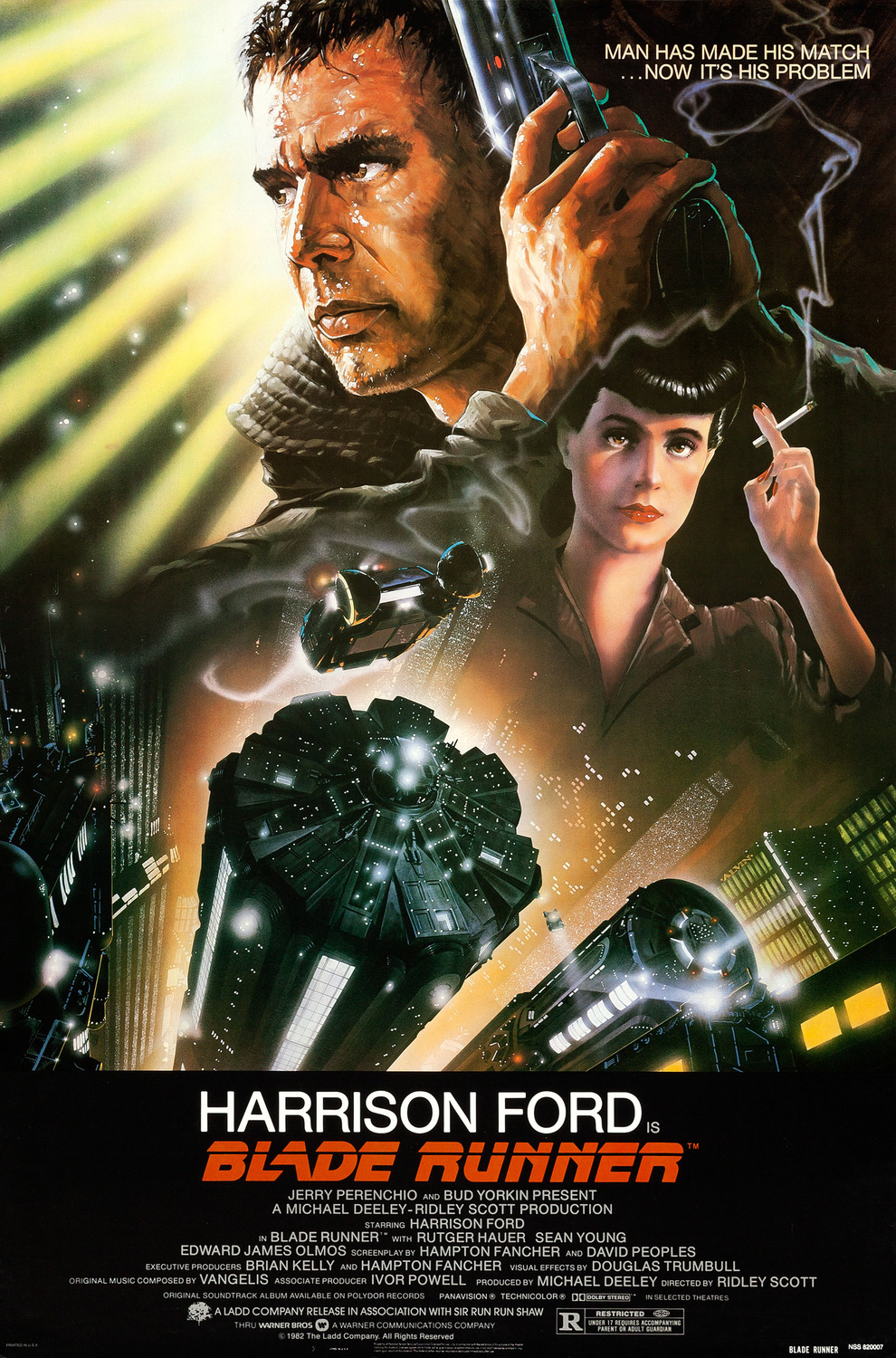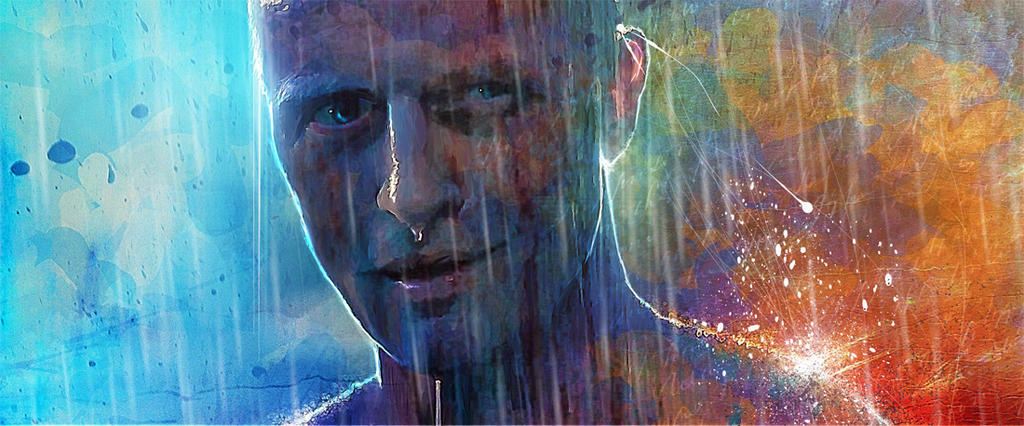 |
| Fig 1. |
"Blade Runner" (1982) directed by Ridley Scott, based on the short story "Do Android's Dream of Electric Sheep?" (1968) by Phillip K. Dick, is a cyberpunk noir-thriller set in 2019 which centers on Rick Deckard, a retired Blade Runner - a detective that hunts down rogue androids and terminates them - as he is brought back into the fold and tasked with tracking down 4 rogue androids - or "Replicants" in this case.
 |
| Fig 2. |
 |
| Fig 3. |
Rachael, Tyrell's secretary and unbeknownst to her, a "Nexus 6 Replicant", occupies a selection of archetypes here, in that she is not only Deckard's ally but also his lover, and subsequently cut from the cloth of the 'Maiden' archetype; she displays a certain sense of innocence when we first see her, which is lost when Deckard reveals to her that she is a replicant. It is perhaps in these first few moments with Rachael, that Deckard encounters his first "Threshold Guardian", the Voight-Kampff test serves as the first of Deckard's trials.
Though there's evidence that points to Tyrell being both the "Mother" and "Father" here, there is also evidence within the film that Rachael could be considered to inhabit the archetype of "Mother". Mark Lachniel comments that "Through the story, Rachel takes on the Role of the Archetypal mother. Despite the fact that she is a Replicant, she is clearly a force for peace and good in the story. Rachel, despite her supposed lack of humanity, saves Deckert's life. This act further fortifies the premise that she acts as a life-giving influence in the story." (Lachniel, 1998) It certainly seems as though these archetypes are giving us a sense that Rachael is a symbol of ultimate femininity, someone that Deckard wants and vies to understand, but - due to the decreased lifespan - will never have. Lachniel also comments on the biblical qualities of the name Rachael "Rachel's role as a mother figure is clearly reinforced by her precisely chosen name. In the biblical accounts, Rachel is found as the wife of Jacob. In the account, god found that "Rachel [was] barren" and unable to bear children. This is clearly indicative of the vital missing element of the Replicants - the ability to reproduce their own" (Lachniel, 2012) adding another dimension her persona of grand femininity.
Though there's evidence that points to Tyrell being both the "Mother" and "Father" here, there is also evidence within the film that Rachael could be considered to inhabit the archetype of "Mother". Mark Lachniel comments that "Through the story, Rachel takes on the Role of the Archetypal mother. Despite the fact that she is a Replicant, she is clearly a force for peace and good in the story. Rachel, despite her supposed lack of humanity, saves Deckert's life. This act further fortifies the premise that she acts as a life-giving influence in the story." (Lachniel, 1998) It certainly seems as though these archetypes are giving us a sense that Rachael is a symbol of ultimate femininity, someone that Deckard wants and vies to understand, but - due to the decreased lifespan - will never have. Lachniel also comments on the biblical qualities of the name Rachael "Rachel's role as a mother figure is clearly reinforced by her precisely chosen name. In the biblical accounts, Rachel is found as the wife of Jacob. In the account, god found that "Rachel [was] barren" and unable to bear children. This is clearly indicative of the vital missing element of the Replicants - the ability to reproduce their own" (Lachniel, 2012) adding another dimension her persona of grand femininity.
Tyrell can be seen to be both the "Father" and "Mother" archetype, the difference here being that the import is flipped from Deckard to Roy Batty; Tyrell is Batty's sole creator, and therefore inhabits both the mother and father role at the same time. Indeed, this is perfectly showcased in the scene where Batty confronts his maker, Tyrell. Seeking comfort and reason from his maker, Roy ultimately finds that Tyrell is an empty god, offering him no way of escaping his oncoming doom, no sooner as he finds no reason to his existence, he decides to kill Tyrell, ultimately attaining some form of atonement with his father/mother/creator in the process.
The band of Replicants themselves are comprised of a few archetypes, it's a mix that ultimately reinforces their importance to the story at large, but also showcases how dangerous they are. In basic terms, they represent the "Child"; interesting to consider as they're all outwardly 'adult'. The sense of childlike innocence is generated by the fact that replicants have a built in lifespan of 4 years, and because of that are emotionally young and unable to rationalise the vastness of the emotional spectrum they're awakening to. The innocence isn't characterised here for purposes of comedy, but rather for naivety, their inability to handle their impending deaths forcing them to lash out unpredictably.
Roy Batty, leader and supposed "Mentor" of the rogue replicants, appears to be Deckard's "Shadow", in that he's the closest thing to a traditional villain in the film, showcasing some truly brutal tendencies, yet he also mirrors a lot of phobias given life within the film. Notions of what it means to be human run rife here, and the battle between Deckard's emotionally detached persona and the raw and untethered despair of Roy really showcase the differences between the two.
 |
| Fig 4. |
The "Herald" of the film is a shared role of two characters, "Bryant", a detective that forces Deckard out of retirement and into the paths of Roy Batty and the rogue replicants. This call to arms serves as the jumping off point into the larger events of the movie, but also serve to paint Deckard as the reluctant hero, one who actively questions his own actions. The other character is that of "Gaff", the shady detective who initially pulls Deckard into the meeting with Bryant, but also serves as Deckard's 'Virgil'-esque guide throughout the film. Jay Dyer, writing for "JaysAnalysis" says "We don’t learn much about Gaff, yet he does something very significant. Throughout the film, as he leads Deckard, he leaves origami figurines as symbolic indicators that reveal the method to Deckard himself." (Dyer, 2012) and it is true to say that Gaff definitely seems to be guiding Deckard, to where? to what? Ultimately it doesn't matter, unless you lend credence to the idea that Deckard is indeed a replicant. Gaff is also a character that inhabits more than one archetype, which is impressive for a character that has so few lines, he can be seen to be the "Trickster", though not in any obvious way, it is indeed, because of the breadcrumb trail of Origami that Gaff leaves for Deckard, that displays this. If one chooses to believe that Deckard is a replicant, then they can be seen as gentle reminders that Deckard is living a lie, Gaff's attempts at letting him know that he knows. But with the convoluted nature of the many different versions of the film, this can only be assessed by the viewer.
Ultimately, "Blade Runner" is an interesting specimen that excels at combining character archetypes in order to push the narrative into more meaningful places. It is no secret that Blade Runner is stylistically sound, but it is through the use of this complex system of 'archetype juggling' that keeps the characters fresh, believable and three dimensional.
Ultimately, "Blade Runner" is an interesting specimen that excels at combining character archetypes in order to push the narrative into more meaningful places. It is no secret that Blade Runner is stylistically sound, but it is through the use of this complex system of 'archetype juggling' that keeps the characters fresh, believable and three dimensional.
Bibliography
Anderson, Kyle "SCHLOCK & AWE: BLADE RUNNER’S RICK DECKARD IS THE LEAST HEROIC HERO" Nerdist.com [online] http://nerdist.com/schlock-awe-blade-runners-rick-deckard-is-the-least-heroic-hero/ [Accessed 10/10/2016]
Dyer, Jay "Blade Runner: Indepth Esoteric Analysis" jaysanalysis.com [online] https://jaysanalysis.com/2012/05/15/blade-runner-indepth-esoteric-analysis/ [Accessed 10/10/2016]
Lachniel, Mark "An Analysis Of Blade Runner" br-insight.com [online] http://www.br-insight.com/an-analysis-of-blade-runner [Accessed 10/10/2016]
Illustrations
Fig 1. Blade Runner Poster. [image] Available at: http://www.impawards.com/1982/posters/blade_runner_xlg.jpg [Accessed 10/10/2016]
Fig 2. Deckard Aims. [image] Available at: https://pmcvariety.files.wordpress.com/2013/05/bladerunner_sequel.jpg [Accessed on 10/10/2016]
Fig 3. Rachael smoking. [image] Available at: http://s3.amazonaws.com/digitaltrends-uploads-prod/2016/08/blade-runner-rachel-smoking.png [Accessed 10/10/2016]
Fig 4. Roy Batty Painting. [image] Available at: http://img12.deviantart.net/5e9d/i/2014/293/b/4/roy_batty___blade_runner_by_danielmurrayart-d83imgm.jpg [Accessed 10/10/2016]
Fig 1. Blade Runner Poster. [image] Available at: http://www.impawards.com/1982/posters/blade_runner_xlg.jpg [Accessed 10/10/2016]
Fig 2. Deckard Aims. [image] Available at: https://pmcvariety.files.wordpress.com/2013/05/bladerunner_sequel.jpg [Accessed on 10/10/2016]
Fig 3. Rachael smoking. [image] Available at: http://s3.amazonaws.com/digitaltrends-uploads-prod/2016/08/blade-runner-rachel-smoking.png [Accessed 10/10/2016]
Fig 4. Roy Batty Painting. [image] Available at: http://img12.deviantart.net/5e9d/i/2014/293/b/4/roy_batty___blade_runner_by_danielmurrayart-d83imgm.jpg [Accessed 10/10/2016]

No comments:
Post a Comment